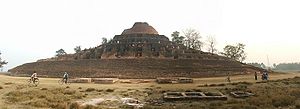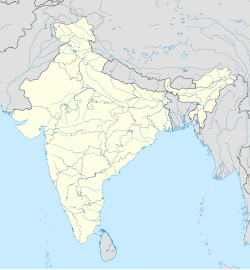Kesaria
This article has multiple issues. Please help improve it or discuss these issues on the talk page. (Learn how and when to remove these messages)
|
You can help expand this article with text translated from the corresponding article in Tamil. (December 2018) Click [show] for important translation instructions.
|
Kesariya
केसरिया Kasariya | |
|---|---|
Town | |
| Nickname: Kesaputta | |
| Coordinates: 26°20′03″N 84°51′17″E / 26.334192°N 84.854820°E | |
| Country | |
| State | Bihar |
| District | East Champaran |
| Government | |
| • Type | State Government |
| • Body | Bihar |
| Elevation | 45 m (148 ft) |
| Languages | |
| • Official | languageHindi, Urdu, Bhojpuri |
| Time zone | UTC+5:30 (IST) |
| PIN | 845424 |
Kesariya is a town in the district of East Champaran, in the Indian state of Bihar. It is the site of a stupa built by the Mauryan king Ashoka.
Geography
It is near Rampur Khajuria. The nearest villages are Noori Mohalla Trilokwa & Trilokwa (3.5 km), Phultakiya (3 km), Baisakhawa (2 km), Ramgadhwa (4 km), Tajpur (6 km), Bairiya (6 km), Bathana (5 km), Nyagaw (4 km).There are also two mosques in the town.
History
Ancient Kesariya (formally known as Kesaputta) was a republic ruled by Kalamas, later annexed by its monarchical neighbor Kosala.
Legend
Alara Kalama, Buddha's teacher before enlightenment, is said to have been from Kesaputta. Buddha is said[according to whom?] to have had a direct connection with Kesaputta. According to Jataka tales, Buddha had ruled this place as a Chakravartin Raja in his previous birth. During one of Buddha's visits to Kesaputta, he gave an essential discourse, the celebrated Kessaputtiya Sutta, popularly known as Kalama Sutta.
The local people call this Stupa Devala, meaning "the house of God." Before the excavation of this, they believed that inside it there is a temple of Shiva which was built by King Bhema.
Kesariya Stupa

| Pilgrimage to |
| Buddha's Holy Sites |
|---|
 |
Initially constructed as a mud stupa, it gained its present structure in the Maurya, Sunga and Kushana period. The stupa dates between 200 AD and 750 AD and may have been associated with the 4th-century ruler, Raja Chakravarti.[1] Kesariya Stupa is 104 feet high.
Huien Tsang mentions having seen the grand Stupa in Kia-shi-po-lo (Kesariya) but it was deserted and overgrown.
The Kesariya stupa was discovered in 1958 during an excavation led by Archaeologist KK Muhammed of Archaeological Survey of India (ASI).
A 1998 excavation of the area surrounding the stupa uncovered significant items, such as Islamic coins, arrowheads, copper and terracotta items, earthen lamps, decorated bricks, etc. Some images of Buddha, in ‘Bhoomi Sparsh Mudra’ and other sitting postures, were found.[citation needed]
Viraat Ramayan Mandir
Viraat Ramayan Mandir is a Hindu temple complex that began its construction in 2012 with an estimated budget of INR 500 crore. When completed, it will be the largest religious monument in the world. The Virat Ramayan Mandir will be almost double the height of Angkor Wat, which is 215 feet high. The temple will have a hall with a seating capacity of 20,000 people.
Transport
Transport and accommodation are available from the state capital, Patna, for visit to the Bodh circuit (Bodhgaya, Rajgir, Nalanda, Vaishali, Kesaria, Lumbini, Kushinagar, Sarnath), Jain Circuit (Rajgir, Pawapuri), and Sikh Circuit in Bihar.[2]
References
- ^ "Kesaria Buddhsit Pilgrimage Tour,Buddhist Pilgrimage Tour in Kesaria India,Kesaria Buddhist Pilgrimage Tour in Bihar,Book for a Buddhist Pilgrimage Tour Kesaria". www.buddhist-pilgrimage.com. Retrieved 2019-01-20.
- ^ Bihar Tourism


